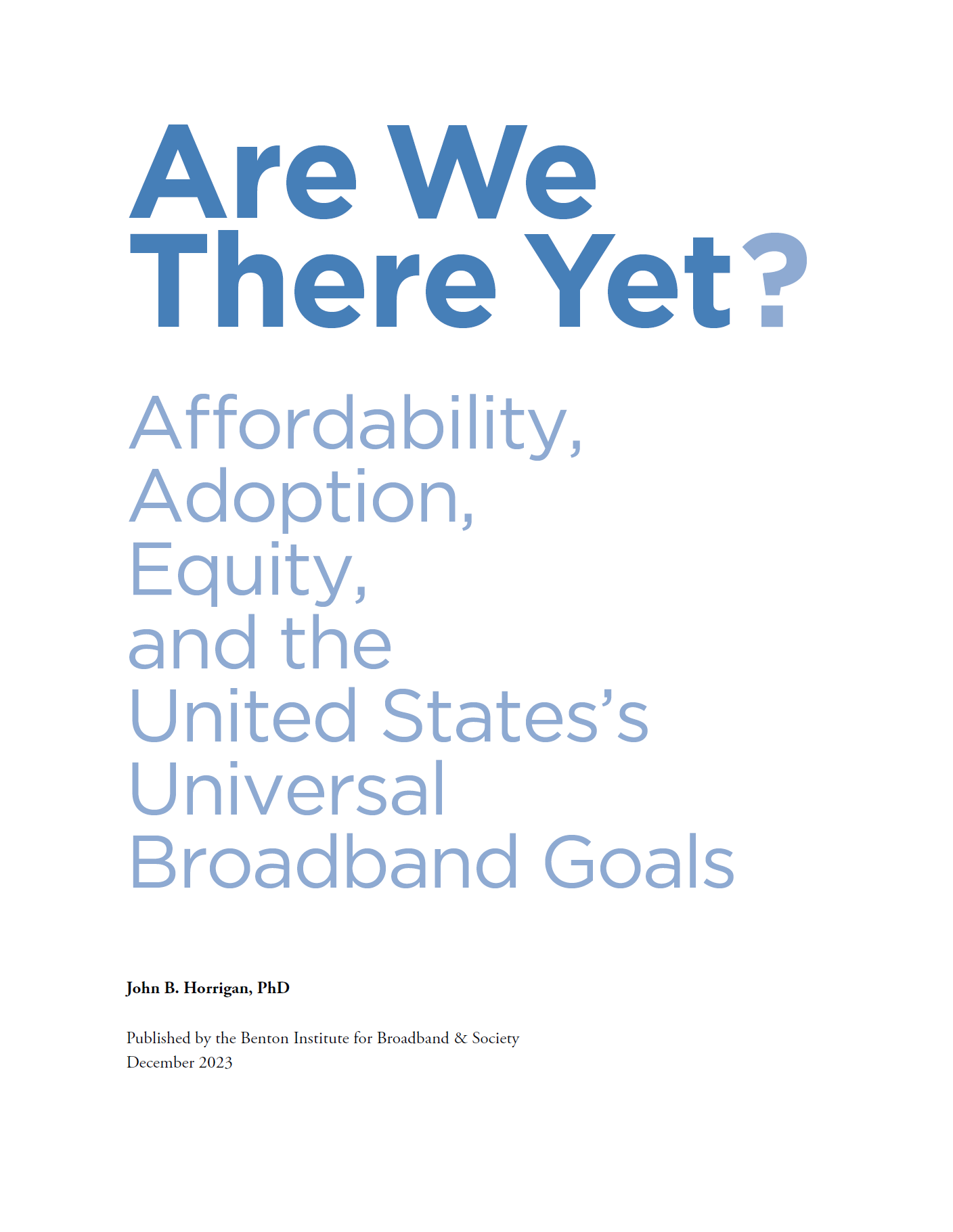Deployment Alone Does Not Tell the Full Story of the Digital Divide
Wednesday, December 20, 2023
Digital Beat
Deployment Alone Does Not Tell the Full Story of the Digital Divide

How should broadband adoption, affordability, and equity impact the Federal Communications Commission (FCC)’s assessment of the availability of broadband for all Americans? A review of recent research indicates that it is not enough for networks to meet just certain deployment benchmarks. Consumer behavior is part of the picture: We cannot reach our universal broadband goals without widespread adoption, and we cannot achieve universal broadband adoption if service is not affordable. Evidence of extensive build-out of very-high-speed networks is a partial indicator of progress toward universal broadband goals. Whether service offerings are affordable and how adoption of them unfolds along lines of income, race, ethnicity, and geography are also important metrics.
Determining whether the United States is progressing toward its universal broadband goals means more than measuring the “where” and “how fast.” The FCC must also include metrics about affordability, adoption, and equity. With broadband adoption gaps still very real and the Affordable Connectivity Program that addresses some of them at risk of ending, the FCC should come to the determination that universal broadband goals are not being met. Specifically:
- Large gaps in broadband adoption between low- and upper-income households suggest that the cost of service, rather than just consumer preference, is inhibiting subscription. Survey research supports this idea, as national surveys of low-income households find that they most often identify cost of the monthly subscription as a reason they lack service.·
- The FCC should recognize that, while pegging an affordability standard to a percentage of disposable household income has merit, other methods yield valuable insights. In particular, consumer surveys inquiring about ability to pay, experience with service disconnection, and other elements can help develop a comprehensive estimate of households’ ability to pay for broadband and the tools that permit use of digital content.
- Employing consumer surveys to help determine affordability-of-services standards also contributes to understanding equity and inclusion issues, in that such surveys can examine the degree to which affordability varies by race, ethnicity, geography, and other demographic characteristics of interest.
- Because subscribing to both mobile and fixed services is the norm in the United States, affordability of service should encompass both service types.
Going forward, the FCC should take a systematic approach to tracking broadband affordability. This would include measuring:
- The price of service paid by consumer income category. This would include what households pay monthly for wireline service and wireless service.
- The speeds to which households subscribe by household income.
- The computing devices households have for internet access and the annual cost households pay for computer purchases and maintenance.
- Consistency of service in a given year, that is, whether a household lost service due to economic difficulties.·Awareness and use of discount programs for service, e.g., the Affordable Connectivity Program and Lifeline.
To achieve this, the FCC could do for broadband adoption what it has done for measuring network speeds, namely, launch a Measuring Broadband Adoption in America initiative modeled on the “Measuring Broadband America” program. The goal would be to develop an approach to measuring adoption and affordability that has widespread acceptance among relevant stakeholders. Measuring Broadband Adoption in America would track change over time in adoption, affordability, and equity measures that are key to assessing progress toward universal broadband goals. By tracking measures of universal broadband beyond network deployment, the FCC can help ensure that there is equitable access to the internet’s benefits for all Americans.
These recommendations are based on an analysis that explores issues of broadband adoption, affordability,and equity. Research into these issues finds that:
- As many as half of low-income households are “subscription vulnerable.”People living at or near the poverty line may be subject to service disconnection if their economic fortunes change. They express worry about service affordability.
- Low-income households do not enjoy the ubiquitous connectivity upon which their higher-income peers rely. They are about half as likely as middle- and upper- income households to have both wireless and wireline means to go online.
- Limits on access have deleterious consequences for social and economic equity.Service affordability—and its impact on adoption—contributes to foregone opportunities for jobs and health care services for low-income households. Internet access and use impacts outcomes in these and other realms
For more, please see the Benton Institute for Broadband & Society's new release "Are We There Yet? Affordability, Adoption, Equity, and the United States’s Universal Broadband Goals."
John B. Horrigan is a Benton Senior Fellow and a national expert on technology adoption, digital inclusion, and evaluating the outcomes and impacts of programs designed to promote communications technology adoption and use.
The Benton Institute for Broadband & Society is a non-profit organization dedicated to ensuring that all people in the U.S. have access to competitive, High-Performance Broadband regardless of where they live or who they are. We believe communication policy - rooted in the values of access, equity, and diversity - has the power to deliver new opportunities and strengthen communities.
© Benton Institute for Broadband & Society 2023. Redistribution of this email publication - both internally and externally - is encouraged if it includes this copyright statement.
For subscribe/unsubscribe info, please email headlinesATbentonDOTorg







